Blue Dream
RSP 11009
Grower: CW NV Cultivators
General Information
- Sample Name
- F20161012-07-1_01FEB2017
- Accession Date
- September 17, 2017
- Reported Plant Sex
- not reported
- Report Type
- StrainSEEK v2 3.2Mb
- DNA Extracted From
- Unknown
The strain rarity visualization shows how distant the strain is from the other cultivars in the Kannapedia database. The y-axis represents genetic distance, getting farther as you go up. The width of the visualization at any position along the y-axis shows how many strains there are in the database at that genetic distance. So, a common strain will have a more bottom-heavy shape, while uncommon and rare cultivars will have a visualization that is generally shifted towards the top.
Chemical Information
Cannabinoid and terpenoid information provided by the grower.
Cannabinoids
- THC + THCA
- 26.64%
- CBD + CBDA
- 0.083%
- THCV + THCVA
- 0.%
- CBC + CBCA
- 0.057%
- CBG + CBGA
- 0.303%
- CBN + CBNA
- 0.087%
Terpenoids
- α-Bisabolol
- 0.002%
- Borneol
- n/a
- Camphene
- 0.006%
- Carene
- 0.001%
- Caryophyllene oxide
- 0.002%
- β-Caryophyllene
- 0.074%
- Fenchol
- n/a
- Geraniol
- 0.%
- α-Humulene
- 0.081%
- Limonene
- 0.076%
- Linalool
- 0.031%
- Myrcene
- 0.349%
- α-Phellandrene
- n/a
- Terpinolene
- 0.004%
- α-Terpineol
- n/a
- α-Terpinene
- 0.%
- γ-Terpinene
- 0.006%
- Total Nerolidol
- 0.008%
- Total Ocimene
- 0.006%
- α-Pinene
- 0.327%
- β-Pinene
- 0.132%
Genetic Information
- Plant Type
- Type I
File Downloads
The bell curve in the heterozygosity visualization shows the distribution of heterozygosity levels for cannabis cultivars in the Kannapedia database. The green line shows where this particular strain fits within the distribution. Heterozygosity is associated with heterosis (aka hybrid vigor) but also leads to the production of more variable offspring. When plants have two genetically different parents, heterozygosity levels will be higher than if it has been inbred or backcrossed repeatedly.
The ratio of reads mapped to Y-contigs to reads mapped to the whole Cannabis genome (Y-ratios) has been demonstrated to be strongly correlated with plant sex typing. This plot shows the distribution of Y-ratios for all samples in our database which were sequenced with the same method (panel or WGS) as this sample and where this sample falls in the distribution.
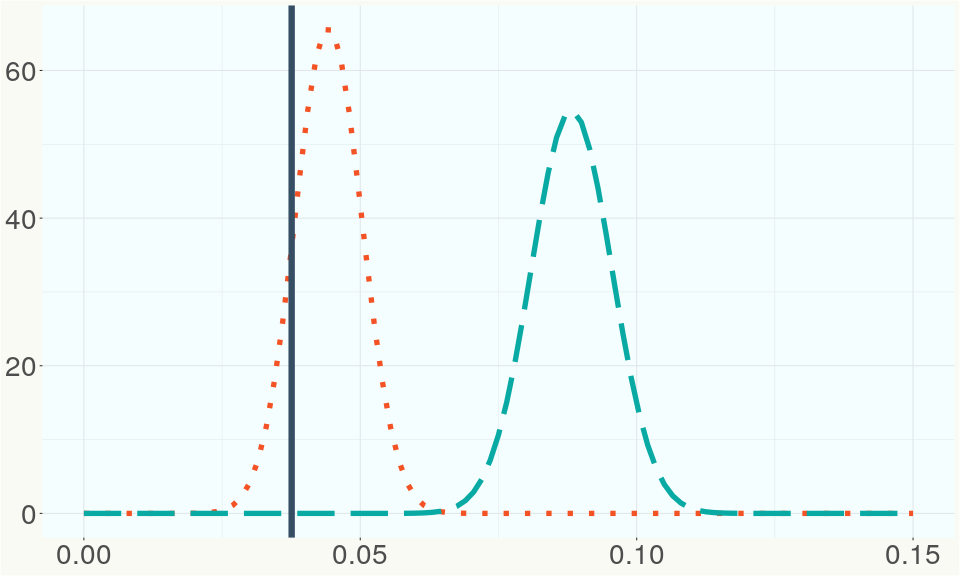
This chart represents the Illumina sequence coverage over the Bt/Bd allele. These are the three regions in the cannabis genome that impact THCA, CBDA, CBGA production. Coverage over the Active CBDAS gene is highly correlated with Type II and Type III plants as described by Etienne de Meijer. Coverage over the THCA gene is highly correlated with Type I and Type II plants but is anti-correlated with Type III plants. Type I plants require coverage over the inactive CBDA loci and no coverage over the Active CBDA gene. Lack of coverage over the Active CBDA and Active THCA allele are presumed to be Type IV plants (CBGA dominant). While deletions of entire THCAS and CBDAS genes are the most common Bt:Bd alleles observed, it is possible to have plants with these genes where functional expression of the enzyme is disrupted by deactivating point mutations (Kojoma et al. 2006).
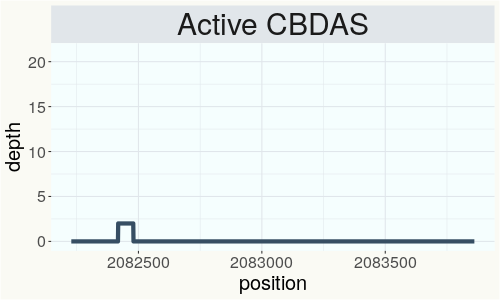
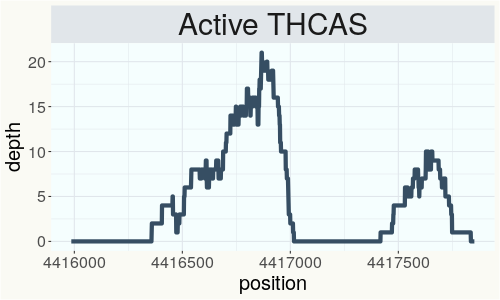
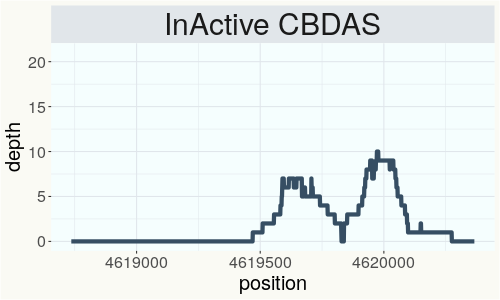
This chart represents the Illumina sequence coverage over the CBCA synthase gene.
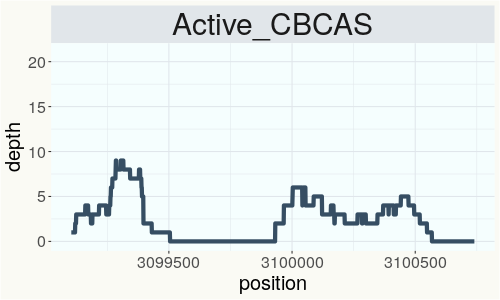
Variants (THCAS, CBDAS, and CBCAS)
No variants to report
Variants (Select Genes of Interest)
Nearest genetic relatives (All Samples)
- 0.001 Blue Dream (RSP11005)
- 0.002 Blue Dream (RSP11227)
- 0.003 Blue Dream (RSP11008)
- 0.003 Snoops Dream (RSP11031)
- 0.003 Blue Dream (RSP11007)
- 0.003 Blue Dream (RSP11012)
- 0.004 Blue Dream (RSP11342)
- 0.004 Blue Dream (RSP11032)
- 0.004 Blue Dream (RSP11017)
- 0.005 Snoops Dream (RSP11003)
- 0.005 Blue Dream (RSP11006)
- 0.006 Super Blue Dream (RSP11011)
- 0.007 Blue Dream (RSP11033)
- 0.010 Blue Dream (RSP11004)
- 0.011 Blue Dream (RSP11010)
- 0.112 Serious Happiness (RSP10763)
- 0.141 Doug s Varin (RSP11243)
- 0.157 UnObtanium (RSP11611)
- 0.161 Domnesia (RSP11184)
- 0.162 Golden Goat 2 (RSP10991)
Most genetically distant strains (All Samples)
- 0.416 Cherry Blossom (RSP11328)
- 0.414 Cherry Blossom (RSP11311)
- 0.412 80E (RSP11213)
- 0.408 80E (RSP11211)
- 0.399 CS (RSP11208)
- 0.394 Carmaleonte (RSP11207)
- 0.392 Feral (RSP11205)
- 0.388 BagSeed (RSP12627)
- 0.388 Unknown--Cherry Wine---003- (RSP11270)
- 0.386 Unknown--Cherry Wine---001- (RSP11268)
- 0.384 Cherry Blossom (RSP11323)
- 0.382 Candy Kush (RSP11492)
- 0.380 Cherry Blossom (RSP11334)
- 0.380 Unknown--Cherry Wine---002- (RSP11269)
- 0.379 80E (RSP11212)
- 0.378 R3in134 (SRR14708220)
- 0.377 Cherry Blossom (RSP11314)
- 0.376 Cherry Blossom (RSP11298)
- 0.376 Carmagnola (RSP11202)
- 0.375 R1in136 (SRR14708226)
Nearest genetic relative in Phylos dataset
- Overlapping SNPs:
- 59
- Concordance:
- 56
Nearest genetic relative in Lynch dataset
- Overlapping SNPs:
- 9
- Concordance:
- 9
Blockchain Registration Information
- Transaction ID
-
082eacaaea7dd0d5
7474de4c4e61fe0b 2c4a82c14ad84116 b3350b550706ea5c - Stamping Certificate
- Download PDF (847.9 KB)
- SHASUM Hash
-
d5e563190125b6f9b30bd5c415c1112f 40593e2e5e1e5c8e 622c821c712efed7